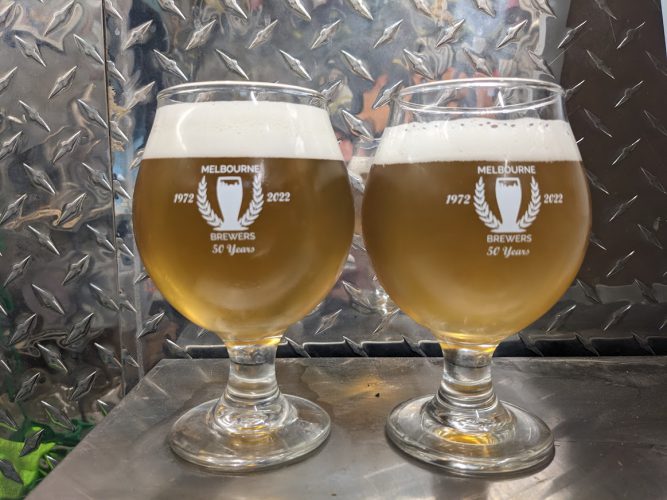Water Chemistry
Water chemistry plays a crucial role in brewing beer. The mineral content of the water can affect the pH of the mash, which in turn affects the conversion of enzymes and the extraction of sugars from the grains. It can also affect the flavor and clarity of the finished beer. Different styles of beer may require different water chemistry. For example, a beer with a high mineral content, such as a German Pilsner, may require different water chemistry than a beer with a low mineral content, such as a Belgian Witbier.
Some of the critical water chemistry parameters that brewers consider include pH, alkalinity, calcium, magnesium, sodium, chloride, and sulfate. These minerals can be adjusted by adding or removing certain minerals or using reverse osmosis or ion exchange to purify the water. Brewers generally aim for a balanced water chemistry to support the finished beer's desired yeast and malt flavors.
Watch This
Hayden gave a great talk on Water Chemistry at the January 2023 Club Meeting.
Download this
We have a great Water Chemistry document written by one of our long-time members Tony Wheeler
key concepts in water treatment
In addition to influencing perceptible aspects of beer, certain minerals in brewing water affect things like enzymatic conversion during the mash, protein coagulation during the boil, and yeast health during fermentation. As such, using straight RO water to brew with is cautioned against. Water is the single largest ingredient in beer, and while adjusting it to a particular mineral profile is viewed as confounding by some, there’s heaps of evidence that indicate doing so has a genuine impact. Despite generally being pure enough to consume on its own, municipal water can vary significantly in mineral composition, making between-batch consistency difficult, if not impossible.
Melbourne Water Profile.
The following data from the South East Water Water Quality Report shows the concentrations in ppm (parts per million) of the ions of importance in brewing. This is from a single year but is pretty representative of the soft water in Melbourne.
| Min (ppm) | Mean (ppm) | Max (ppm) | |
| Calcium (Ca2+) | 3 | 5 | 13 |
| Magnesium (Mg2+) | 1 | 2 | 26 |
| Sodium( Na+ ) | 4 | 8 | 73 |
| Bicarbonate (HCO3-) | 6 | 12 | 110 |
| Chloride (Cl- ); | 6 | 12 | 93 |
| Sulphate (SO42- ); | 1 | 3 | 10 |
| pH | 6.4 | 7.5 | 8.5 |
Some outlying maxima are a little disconcerting, but hopefully, they are rare. The mean concentrations for practical water treatment are so low as to be considered zero. It soon becomes evident that Melbourne water is calcium deficient and requires calcium addition for all brewing. The same applies to rainwater.
January 2023
exBEERiment
At the January 2023 Club meeting, we conducted a Brulosophy style Experiment
The test was a German pilsner made with Melbourne Water vs. a German Pilsner made with significantly higher calcium, sulfate and chloride
This was similar to a past xBmt where tasters were able to tell apart a Pilsner made with pure RO water from one where the water was adjusted with minerals
Recipe Details
| Batch Size | Boil Time | IBU | SRM | OG | FG | ABV |
|---|---|---|---|---|---|---|
| 20L | 70 min | 25 IBUs | 4.8 SRM | 1.052 | 1.011 | 5.4 % |
Fermentables
| Name | Amount | % |
|---|---|---|
| Pilsner (Weyermann) | 5 kg | 97 |
| Cara Pils(Weyermann) | 150 g | 3 |
Wate Adjustments
| Name | Mineral Adjusted | Melb Water |
|---|---|---|
| CaSO4 | 2.5 g | - |
| CaCl2 | 2 g | - |
| MgSO4 | 2 g | - |
| Lactic Acid | 2ml | 2ml |
Water Profile
| Water Profile (Adjusted batch): Ca: 60| Mg: 9 | Na: 6 | SO4: 90| Cl: 61 |
| Water Profile (Mel Water): Ca: 5| Mg: 1 | Na: 6 | SO4: 3| Cl: 10 |
Hops
| Name | Amount | Time |
|---|---|---|
| Tettnanger | 25 g | 60 min |
| Hallertau Mittelfruh | 25 g | 60 min |
| Tettnanger | 25 g | 5 min |
| Hallertau Mittelfruh | 25 g | 5 min |
Yeast
| Name | Lab | Attenuation | Temperature |
|---|---|---|---|
| German Lager I | Omega | 72% | 50°F - 60°F |
Results
12 Club members participated in this xBmt. Each participant was served two samples of the Mineral Adjusted beer and 1 sample of the Melbourne Water beer in opaque white cups. They were asked to identify the unique sample. At this sample size, 8 tasters (p<0.05) would have had to identify the unique sample to reach statistical significance, Unfortunately only six made the correct choice. These results indicate participants in this xBmt could not distinguish a Pilsner made with Melbourne Water from one made with water built up to desired water profile.
Triangle Test
| Testers | Needed to be correct for Significance | Correct if only Random |
| 12 | 8 | 4 |
| Actual # correct | Ou of 12 Testers | P-Value |
| 6 | 12 | 0.17 |
Comments
As the brewer, I have done several triangle tests of these beers and have not been able to differentiate reliably. They look and taste the same. It will not stop me from adjusting my water chemistry in the future, but at least in this trial, there seems to be little difference between these two beers.
